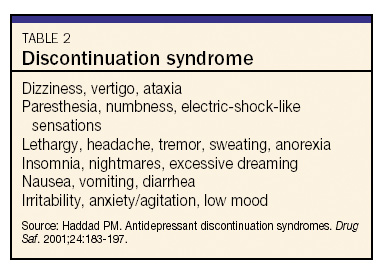
When you try to stop taking the antidepressant, you can experience withdrawal symptoms like: headaches. Papakostas, abruptly stopping antidepressants can result in discontinuation symptoms (such as nausea, insomnia, and agitation ) for a week or two, but most patients are able to. While the syndrome may cause mild symptoms such as nervousness , agitation , tremor , diaphoresis , shivering , mydriasis , hyperreflexia and diarrhoea , in more severe cases tachycardia , hyperthermia , hypertension , myoclonus , muscular rigidity and delirium can occur. If you have been taking the old antidepressant for at least weeks, there is a risk of withdrawal. As many antidepressants have serotonergic activity, serotonin syndrome can occur during antidepressant switching.

Turns out SDS is incredibly common and can cause a mish-mash of symptoms to make you miserable: flu-like dizziness, nausea, fatigue, chills ,. Your antidepressant may also help with your symptoms of anxiety or pain, which may feel worse after you stop taking the medication. There may be a very slow decrease of the one medication needed in order to adjust your body to accepting a new one. This is just my humble opinion. I was only ever on one antidepressant and then I titrated myself off of it over the course of two and a half months. If you have problems with anxiety or chronic pain, you should be particular careful about discontinuing medication as you may be more likely to relapse.
Antidepressants take time to work and some can cause unpleasant side effects like dizziness, nausea, sweaty palms, and diarrhea. When you put all that together, you may start to doubt the value of a medication that takes a month to make you feel better. Chances are good that you will feel better, eventually. Certain antidepressants , such as Effexor (venlafaxine), leave your system quickly and therefore can cause withdrawal symptoms. All antidepressant switches must be carried out cautiously and under close observation.

Symptoms of antidepressant discontinuation syndrome include the dizziness, thirst, nausea and headache Emily experience as well as shock-like sensations throughout your body, insomnia, anxiety, agitation an in rare cases, psychosis. Which Company Is Disrupting a $4Billion Dollar Industry? Read our Report and Find Out!
Patients should be informed that antidepressants can cause discontinuation symptoms if stopped abruptly after prolonged used. Antidepressant discontinuation syndrome, also called antidepressant withdrawal syndrome, is a condition that can occur following the interruption, reduction, or discontinuation of antidepressant medication. Tips for Relief from Withdrawal Symptoms Stick to Your Schedule. It is unlikely that withdrawal symptoms will occur after cessation of low-dose tricyclics used in pain treatment. I’ve been through debilitating anxiety in the past year.
He has me taking Effexor (150) in am, 12. Paxil with lunch, and skipping nighttime 1nighttime Effexor. Learn the correct way to switch antidepressants and understand why you should never suddenly stop taking antidepressant medication. There are three main ways your doctor can switch you to another antidepressant : xvii. Im on tricyclic antidepressants , called Tofranil.
The med are you taking is called SSRI. The tricyclics like Tofranil and Elavil are the older antidepressants , but are very good for high anxiety. Direct switch: stop the first antidepressant abruptly and start new antidepressant the next day. Switching antidepressants can be accomplished by the following strategies: 1. Common symptoms of withdrawal include: depression. Loss of interest in activities that used to give you pleasure.

Weight loss or weight gain, or changes in appetite. Difficulty concentrating, or feeling like your thoughts and movements are slow. Because of the risk of acute withdrawal symptoms (e.g. cholinergic rebound) and the risk of relapse, most antidepressants are gradually tapered. The aim of this paper is to review the evidence regarding when to switch antidepressants and the optimal approach to switching.
Current dose of antidepressant Duration of antidepressant treatment (if less than six weeks it may be possible to stop the antidepressant abruptly) The need for a. DISCONTINUATION SYMPTOMS. Abruptly stopping or rapidly tapering antidepressants often causes adverse effects, especially if a new drug with overlapping pharmacodynamic activity is not started.
No comments:
Post a Comment
Note: Only a member of this blog may post a comment.